Viruses are acellular infectious particles minimally made up of a core of genetic material (DNA or RNA) protected by one or more proteins. SARS-Cov-2 is a virus that causes CoViD-19, the pandemic disease that has taken over our lives in the past months. Like other “enveloped” viruses, it has an additional protective covering of lipid bilayers (a class of compounds that includes fats). On the other hand, viroids or subviral agents are made up of just naked RNA. Viruses (and viroids) can only reproduce inside cellular organismal hosts. They enter cells, use the host machinery to multiply, get released, and again enter other cells to continue the cycle. Incidentally, viruses may cause disorders of disease in their hosts, but this is not always the case. This is their existence.
[Acellular forms do not have ribosomes, the protein-synthesizing machinery, while cellular forms do.]
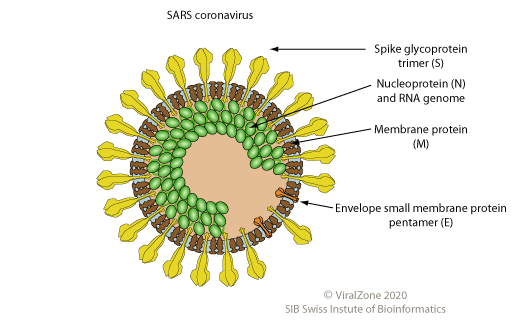
References / Resources
- [General] Where do viruses come from? : An eight minute video that discusses how viruses become molecular fossils, the time since viruses might have existed with virus-first model, escape hypothesis and regressive model-PBS 2018
- [General/HS+] Basic introduction to viruses : A resource that briefly mentions the first sighting of viruses, how they infect cells and their possible roles in extinction of organisms and biotechnology.
- [HS+] Viruses : A general introduction that explores the simplest yet most intriguing features of cells and explains the possible theories of origin of viruses, with links to other articles
Are viruses living beings?
Most biologists would list the following processes as characterising living beings that make up the biosphere: reproduction, metabolism, response to external stimuli, homeostasis, evolution.Viruses can reproduce and evolve. They may be susceptible to external environmental conditions, but cannot respond to them except passively. By these criteria, viruses do not show all the features of living beings. Are they “partly” alive? Some people assert that the well-known three domains of life represent one mode, the ribosome encoding organisms REO (bacteria, archaea, eukarya), and that acellular viruses represent another mode, the capsid encoding organisms, CEO. This is a subject of much discussion, and some biologists think it is futile to try to resolve the dispute of whether viruses are living organisms or not.
The virosphere and kinds of viruses
Viruses are extraordinarily numerous (the estimated number of virus particles is as much as 1 x 1033) and occur wherever there is any form of life, including in extreme hot deep sea vents. On the other hand, there are far fewer identified species of viruses (an estimated 6590, however defined, and ignoring the huge number of subspecies) compared to estimates for instance, for bacteria (30,000).
SARS-CoV-2 is one kind of virus that we all became familiar with in 2020. Its closest relative is SARS-CoV (which caused the first severe acute respiratory syndrome, SARS, epidemic of 2002-2003) and the two are considered to be subspecies of a single species, SARS-CoVs. There are other viruses that are similar to SARS-CoV but different enough to be classed as different species, e.g., MERS-CoV (causes a different type of respiratory illness), and HCoV 229E and OC43 (cause forms of the familiar cold). This larger set of viruses are placed in the family Coronaviridae (commonly coronaviruses), which infect mammals such as bats, civet cats and pangolins, and also birds. Coronaviruses and their closest relatives are classified by the Nidovirales Study Group of the International Committee for Taxonomy of Viruses based on variation in RNA dependent RNA polymerase and nidovirus replicase proteins.
Like coronaviruses, there are many other groups of viruses. Traditionally, viruses were broadly classified (Baltimore classification) based on what kind of genetic material they have (DNA or RNA; single stranded, or double stranded).
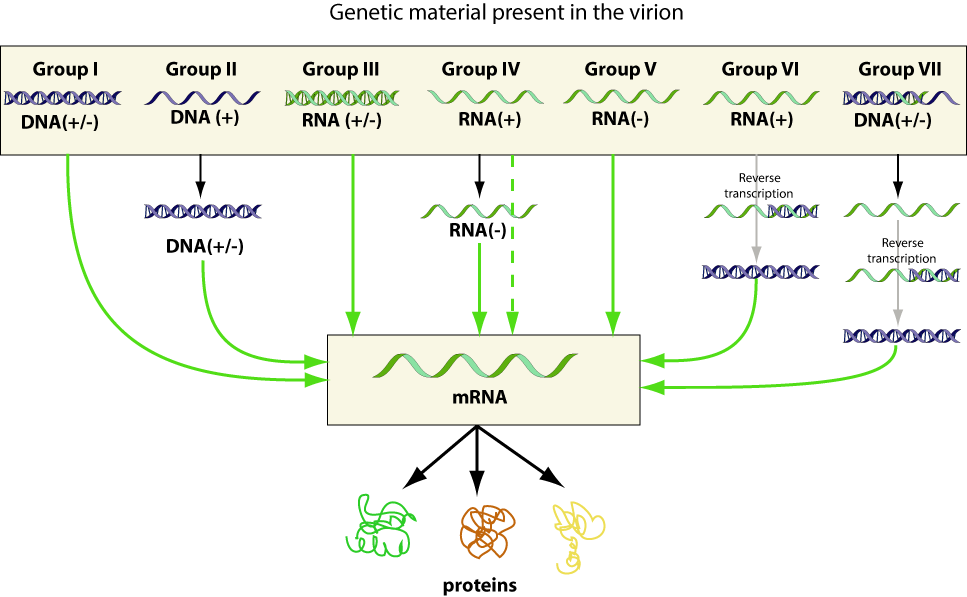
Recently it was suggested that a better way to classify viruses would be to use the type of host they infect (bacteria, plants, mammals, etc) as the basis. Virus classification is difficult because there are no universal genetic markers (comparable to ribosomal RNA in cellular forms) whose sequence can be used to understand relationships among different virus families. The International Committee on Taxonomy of Viruses has Study Groups for each virus family which decide naming and classification strategies, which may differ between families.
References / Resources
- [UG+] Introduction to the Universal System of Virus Taxonomy (Murphy et al., 1995) in “Virus taxonomy” : A brief history of early virus classifications and an introduction to the International Committee on Taxonomy of Viruses (ICTV), which coordinates the naming and classification of viruses
- [UG+] Virus Taxonomy: 2019 Release EC 51, Berlin, Germany, July 2019 Email ratification March 2020 (MSL #35) 4 realms, 9 kingdoms, 16 phyla, 2 subphyla, 36 classes, 55 orders, 8 suborders, 168 families, 103 subfamilies, 1421 genera, 68 subgenera, 2019 6590 species
- [UG+/PG] Nidovirales (Enjuanes et al., 2008) : the larger group / order that Coronaviruses belong to.
Given that new types of viruses are found frequently, much more needs to be done before we can understand the huge diversity of viruses, how the different types are related to each other, and when, where and how they originated. New approaches to this vexing problem include the use of protein folding patterns and machine learning to analyse genomes of different lineages (see below).
Origin and evolution of SARS-CoV-2 and Coronaviruses
Coronaviruses share several genes that allow us to create phylogenetic trees that show the relationships of all species (and subspecies) of these viruses. The genes are homologous across species, and are aligned to estimate phylogenetic trees based on their similarities and differences, giving support to the taxonomic classification of alpha, beta and gamma coronaviruses that infect mammals, and delta corona viruses that infect birds.
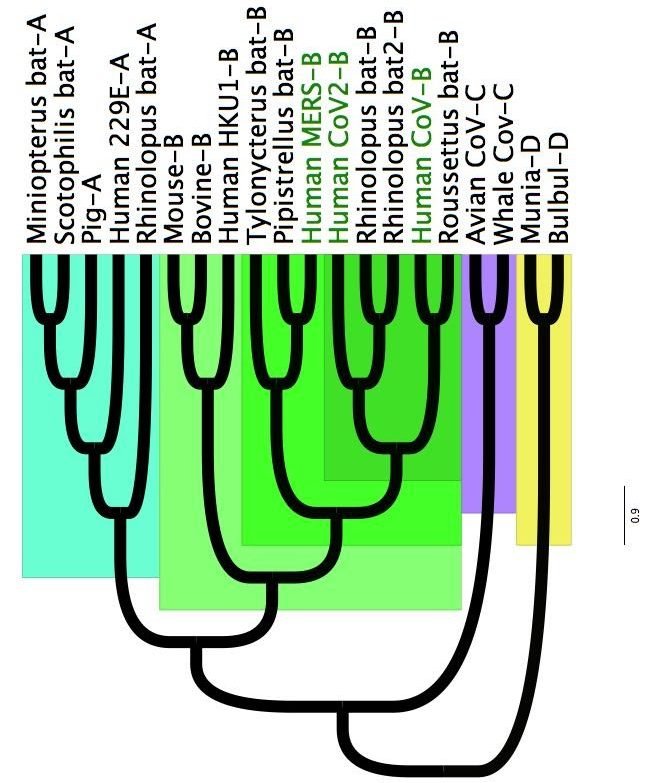
Comparisons of entire genome sequences allow us to determine that one version of the beta virus SARS-CoV-2 arose in bats, some descendents jumped into pangolins, and others might have jumped into humans from either pangolins or bats.
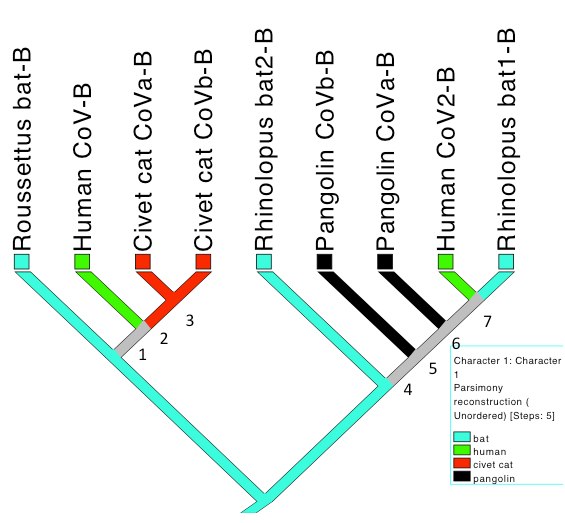
References / Resources
- [HS/UG] Evolutionary trees: A primer
- [HS/UG] Building a phylogenetic tree : The logic behind phylogenetic trees. How to build a tree using data about features that are present or absent in a group of organisms
- [HS/UG] Evolution: Process and History : Basic introduction to evolutionary processes and evolutionary history, with some exercises
- [UG+] Coronaviruses : summary of coronaviruses
- [UG/PG] Evolution of an outbreak : Where did the new coronavirus SARS-CoV-2 come from? It is most closely related to a bat virus, but because the next closest relatives are viruses in pangolins, it is possible that it went from bats to pangolins, multiplied there and then jumped to humans and again into bats. In the process there appears to have been recombination between these different forms.
- [UG/PG] E-learning courses on (a) Phylogenetics of animal pathogens:basic principles and application, (b) BLAST and Multiple Sequence Alignment programs
Origin and evolution of all viruses
Until recently, it was most generally accepted that acellular viruses are derived from their cellular hosts, and that they evolved by either progression (elaboration of ancestrally simple forms) or regression (simplification of ancestrally elaborate forms). Recently, a radically different view has been added – especially after the discovery of giant viruses that are bigger than some bacteria and infect amoeba and virophages that can infect these giant viruses, both suggesting continuity with cellular life – that viruses came first and had a major role to play in the origin of cellular life.
The predominant view of viruses, that they are acellular “products” of cellular organisms, was long thought to be very strongly supported based on diverse types of evidence. The view starts with the assessment that viruses cannot be ancestors of cellular forms because they are not living, that there is no known “ancestral” virus – different types of viruses infect different hosts and do not share any genes in common, and viruses “steal” genes from their hosts (in fact, we now understand that host cells may steal more genes from viruses than the other way around — the human genome may be made up of as much as 8% viral genetic material!).
Folding patterns of proteins in capsids are common to all viruses, and this similarity has been interpreted variously as being 1) due to convergent evolution, consistent with the virus-as-cellular-byproduct view) or 2) due to homology, an ancestral feature inherited from ancient viruses, which would make viruses very old, perhaps older than cellular forms! This controversial “virus-first” theory further says that viruses were key in the origin of the cellular form of life itself. Genome sequencing of diverse viruses repeatedly reveals coding regions that are not homologous to known proteins, and this is taken to point to the antiquity of viruses and their independence from cellular forms of life.
Is there a tree of viruses and where (if at all) does it link to the tree of (cellular) life?
As we saw, genome sequences of Coronaviridae (coronaviruses) can be aligned and analysed to determine relationships among its species, and similar analyses are individually possible for the tobacco mosaic virus family, Virgaviridae. However, because the two families do not share any genes in common, it is not possible to determine the relationships of Coronaviridae to Virgaviridae or even to Orthomyxoviridae (influenza viruses). Thus, different virus lineages appear to share no common history, and it appears to be impossible to estimate a tree of viruses. On the other hand, different virus families share different sets of genes with different cellular forms of life (REOs), suggesting that there is at least a partial shared history with them.
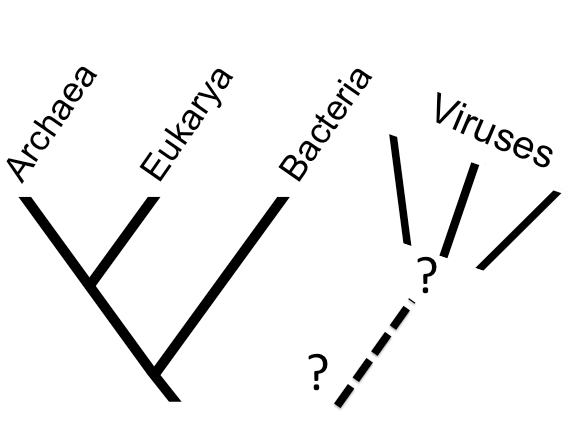
Historically, these two facts have been taken to mean that viruses independently evolved from the lineages of bacteria, archaea and eukarya that they infect, and did not evolve and diversify from a single ancestral virus. However, various bits of evidence accumulated over the years have led to the suggestion that viruses might represent a fourth (acellular) domain of life with a common history. Where might such a fourth domain sit in the tree of life?
Virologists try to use diverse new ways to address these questions. A recent study used network analysis and machine learning to align the genomes of all lineages of viruses and obtain groupings that roughly correspond with both Baltimore and host based classification. This study demonstrates the unity of viral forms, and also our ability to detect evolutionary relationships of these traditionally defined lineages. Analysis of patterns of protein folding link cellular and acellular forms in a single tree, but these results need to be further investigated. For instance, giant viruses are placed closer to eukarya than to either bacteria or archaea in phylogenetic analyses of RNA polymerase, which is present in giant viruses and all cellular life, and this result is interpreted to mean that these viruses contributed to the origin of eukaryotic cells. There are sure to be more surprises in the future of virology!
References / Resources
- [General] Where Did Viruses Come From? (PBS 2018) : A video on virus origins. Is there a fossil record? No, but like cellular life forms, molecular sequences may retain hints of their origins. The discipline of “Palaeovirology” uses viral genomes to unravel their evolutionary history.
- [UG+] The Origins of Viruses (Wessner, D. R., Nature Education 3(9):37 2010) : Review article on the basics of viruses. Are viruses alive? Where did viruses come from? The progressive hypothesis, the regressive hypothesis, the virus-first hypothesis — no single hypothesis may be correct
- [UG+] Introduction to Virus Ecology and Evolution (Paul E. Turner, Yale): YouTube lecture series on Viruses. “Part 1: Dr. Paul Turner describes the fundamental biology of viruses, how they interact with their host organisms, and how they might have originally evolved long ago.”